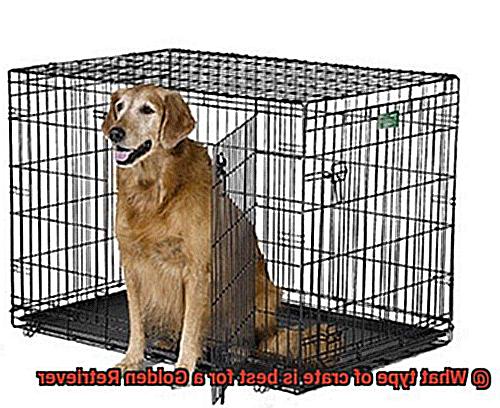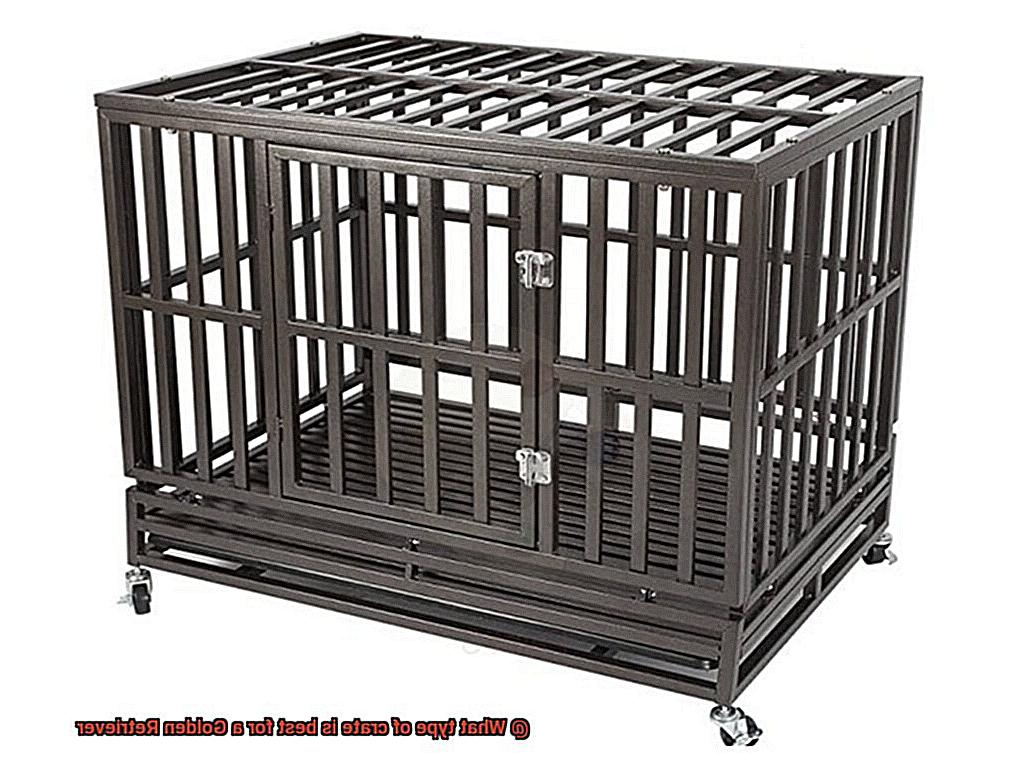Golden Retrievers – the epitome of a perfect family pet. They’re smart, affectionate, and always ready to play. But there are times when you need to keep your furry friend safe and secure in a crate. Whether it’s for traveling, sleeping or training purposes, choosing the right type of crate can be overwhelming. With so many materials, sizes, and designs available on the market, new pet owners may feel lost in the sea of options.
But fear not. We’ve got your back. In this post, we’ll guide you through the world of dog crates and help you decide which one is best for your Golden Retriever. From plastic to metal and fabric crates, we’ll weigh up the pros and cons of each type so that you can make an informed choice. We’ll also discuss sizing – because nobody wants their pooch feeling cramped – as well as important features such as portability, ventilation, and security.
So, let’s dive in.
Size Considerations for Golden Retriever Crates
Contents
A crate can provide just that, but selecting the right size crate is crucial for your dog’s safety and comfort. Here are some things to keep in mind when choosing a crate for your Golden Retriever.
First and foremost, size matters. Your pup should have enough room to stand up, turn around, and lie down without feeling cramped or uncomfortable. A crate that is too small can cause anxiety and unwanted behavior in your dog. As a rule of thumb, a 36-inch long, 24-inch wide, and 27-inch tall crate should be sufficient for most adult Golden Retrievers. However, every dog is unique, and you may need to consider their size and preferences when choosing the right crate.
The weight of your Golden Retriever is also an essential consideration. Larger dogs require sturdier crates that can support their weight without buckling or collapsing. Metal or thick plastic crates are great options for larger dogs because they’re durable and can withstand wear and tear.
It’s also important to consider how long your dog will be spending in the crate. If it’s only for short periods like car rides or running errands, a smaller crate may suffice. However, if your pup will be in the crate for extended periods while you’re at work, it’s essential to choose a larger one that allows them plenty of space to move around and stretch their legs.
In addition to the size of the crate itself, make sure that the door is large enough for your Golden Retriever to enter and exit comfortably without getting stuck or injuring themselves.
Lastly, think about the material of the crate. Wire crates are popular because they offer good ventilation and are easy to clean. However, if your Golden Retriever likes to chew on things, a wire crate may not be the best option. Plastic or composite crates can provide more privacy and security for your dog, but they can also trap heat and limit ventilation. Make sure to choose a crate with proper ventilation holes.
Types of Crate Materials

The material of the crate is just as important as its size and safety features. Let’s take a closer look at the advantages and disadvantages of each type of crate material available on the market.
Firstly, we have plastic crates. These crates are easy to clean, lightweight, and durable. They also meet most airline requirements, making them ideal for travel. However, if your furry friend is a chewer or scratcher, they may easily damage the plastic material.
Next up, wire crates are a popular choice amongst pet owners. They offer great ventilation and visibility for your dog and are collapsible for easy storage. However, if your dog is prone to anxiety, they may feel overwhelmed by their surroundings as they can see everything around them.
Wooden crates are known for their sturdiness and aesthetic appeal that can blend in well with your home decor. They also offer good insulation, making them perfect for colder climates. However, they can be heavy and difficult to move around. Moreover, if your furry friend enjoys chewing or scratching their things, they can easily damage the wood material.
Lastly, soft-sided crates are lightweight, portable, and ideal for travel with good ventilation and visibility for your dog. However, if your furry friend has a habit of chewing or scratching their belongings, they may easily damage the soft fabric material.

In conclusion, each type of crate material has its own unique set of advantages and disadvantages. It’s crucial to consider your dog’s behavior and needs before selecting a crate that works best for them. Remember to choose a crate that provides enough space for your furry friend to move around comfortably and keep them secure at all times.
Plastic or Composite Crates
It can be a daunting task with so many options available, but let me help you navigate between two popular choices: plastic and composite crates.

Plastic crates are an excellent option for pet owners who frequently travel with their furry friends. They are lightweight, durable, and easy to clean. Plus, they come in various sizes and door configurations to suit your pet’s needs. However, some Golden Retrievers may not feel comfortable in an enclosed space, which is something to consider before making a purchase.
Composite crates offer a more natural look and feel than plastic crates. They are made of a mixture of materials such as plastic, metal, and wood, providing your Golden Retriever with a sturdy and durable space to rest. These crates also come in different sizes and door configurations to suit your pet’s needs. However, some composite crates may be heavier than plastic ones, making them less convenient for travel.
When choosing between plastic and composite crates, it’s vital to consider your Golden Retriever’s size, behavior, and needs. Some Golden Retrievers may prefer the open feel of a composite crate, while others may prefer the enclosed feel of a plastic crate. It’s also important to factor in any potential health concerns your pet may have, such as allergies to certain materials.
Wire Crates
Look no further than wire crates. These metal wire crates are a popular choice among dog owners, and for good reason. They offer excellent visibility and ventilation for your furry friend, while being easy to clean and maintain.
When selecting a wire crate for your Golden Retriever, keep their energetic nature in mind. You’ll want to choose a sturdy and durable option that can withstand their playfulness. A weak or flimsy crate simply won’t cut it for these active pups.
Size is also crucial when it comes to wire crates. Your Golden Retriever should be able to stand up, turn around, and lie down comfortably in their crate. Anything too small could leave them feeling cramped and uncomfortable.
And don’t forget about wire spacing. It’s important to choose a crate with wires that are spaced closely enough to keep your pet safe and secure. With the right wire crate, you won’t have to worry about any escaping or getting stuck between wires.
Considerations for Indoor vs Outdoor Use
When choosing a crate for your dog, the first consideration is whether it will be used indoors or outdoors.
Indoor crates are ideal for training purposes, as they offer a safe and secure environment for your Golden Retriever to learn and grow. A well-ventilated crate that is spacious enough for your dog to move around and stretch out comfortably is essential. Additionally, look for a crate with a securely closing door to ensure your dog’s safety.
If you plan to use the crate outdoors, durability is crucial. Your Golden Retriever’s crate must be able to withstand harsh weather conditions and keep your dog safe and secure at all times. Opt for heavy-duty plastic or metal crates with secure latches and ample ventilation.
It’s also crucial to choose an appropriately sized crate – not too large that it makes your dog feel exposed but large enough for them to stand up and move around comfortably.
Ultimately, the decision between an indoor or outdoor crate depends on your needs and lifestyle. If you live in areas with extreme temperatures or frequently travel with your Golden Retriever, an outdoor crate may be more suitable. However, if you’re primarily using the crate for training purposes, an indoor crate may be more appropriate.
Training Purposes for a Crate
Selecting the right type of crate and introducing it correctly is crucial.
For training purposes, I recommend wire or plastic crates. Wire crates offer better ventilation and visibility, allowing your dog to feel less confined and more comfortable. Meanwhile, plastic crates provide a cozy den-like environment that can make your dog feel secure and safe. Choose the crate that best suits your pup’s individual needs.
But introducing the crate to your Golden Retriever is the most important part. Start by leaving the door open and placing some treats or toys inside, encouraging your pup to explore the crate independently. Gradually increase the time your dog spends in the crate, rewarding them with treats or praise for good behavior.
Remember, never force your dog into the crate or use it as punishment. This can create negative associations and make training more challenging. Instead, use positive reinforcement techniques to make it an enjoyable experience for your pup.
When selecting a crate for training purposes, consider your dog’s size, temperament, and individual needs. With patience and positive reinforcement, a crate can be a valuable tool in helping your Golden Retriever learn good behavior and feel safe and secure in their home environment.
Conclusion
As you wrap up your search for the perfect crate for your Golden Retriever, keep in mind that size matters. Your furry friend needs enough space to stretch out and move around comfortably. But it’s not just about size – consider the material of the crate too. Will it be used indoors or outdoors? Plastic crates are great for travel, while wire crates offer excellent ventilation and visibility for training.
Composite crates provide a natural look and feel, while wooden crates offer good insulation in colder climates. Soft-sided crates are lightweight and portable but may not be suitable for dogs who love to chew or scratch.
Remember, introducing the crate gradually and positively is key to avoiding negative associations with it. With patience and positive reinforcement techniques, a crate can be a valuable tool in helping your Golden Retriever learn good behavior and feel safe and secure at home.
It’s important to note that each dog is unique and may have different preferences when it comes to their crate. By considering your dog’s behavior, needs, and temperament, you’ll be able to select the perfect abode for your beloved Golden Retriever.









